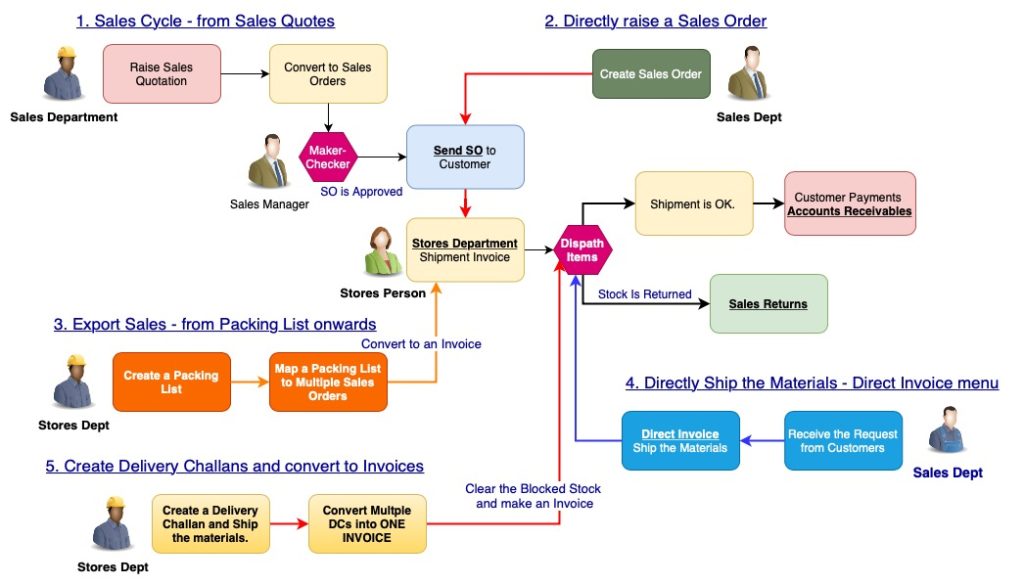The Power of an Order Management System
What is Order Management System?
An Order Management System (OMS) is a comprehensive software solution that facilitates the end-to-end management of orders and sales processes for businesses. It serves as a centralized platform to efficiently process, track, and fulfill customer orders, from the initial placement to final delivery. An OMS streamlines the entire order lifecycle, enabling businesses to optimize their operations and deliver exceptional customer expectations and increases customer satisfaction.
An enterprise resource planning or warehouse management software can help to manage end to end fulfillment process with a clear Inventory visibility to delivery of items as per the schedule. Few tools have an ability to email or SMS to customer at each stage of entire fulfillment process like ecommerce business and it increases seamless customer experiences and increases customer communications. Depending on the business model, you need to go for the right software tools to help you.
Cloud-based solution can manage an inventory control and planning from customer demands to check the stock levels at distribution centers or in house stores to shipment and delivery to customer places.

Why do we need an Order Management System (OMS System)?
In today’s fast-paced and competitive business landscape, efficient order management is essential for success. As businesses grow and expand, handling orders manually becomes cumbersome and error-prone. An Order Management System automates and standardizes the entire order process, ensuring seamless coordination between various departments, such as sales, inventory, and shipping. It not only saves time and effort but also significantly reduces the risk of errors and delays.
How ACTouch ERP helps to manage your Order Management System?
Below is the Sales Order Processing flowchart that includes different departments like Sales, Stores, Production and Planning departments.

Benefits of using an Order Management System
Improved Order Accuracy
An OMS Systems minimizes manual data entry, reducing the chances of errors in order processing. For example, if a customer places an order for five units of a product, the OMS ensures that the correct quantity is recorded and fulfilled.
Streamlined Order Processing
With an OMS, orders are automatically routed to the appropriate departments, eliminating the need for manual handovers. This leads to faster order processing and timely delivery. For instance, when a new order is received, the OMS can automatically send it to the warehouse for picking and packing.
Inventory Optimization
OMS keeps real-time track of inventory levels and updates them as orders are processed. This prevents stockouts and overstocking situations, ensuring that businesses maintain optimal inventory levels. For example, when an order is fulfilled, the OMS deducts the sold items from the available stock.
Enhanced Customer Experience
Quick order processing, accurate order fulfillment, and timely deliveries contribute to a positive customer experience. For instance, if a customer receives their order promptly and without errors, they are more likely to become repeat buyers and recommend the business to others.
Integration with Multiple Sales Channels
OMS enables businesses to manage orders from various sales channels, such as online stores, physical stores, and marketplaces, all from one centralized platform. For example, if a customer places an order online, the OMS can automatically sync the order details across all connected channels.
Order Tracking and Transparency
OMS provides customers with real-time order tracking updates, keeping them informed about the status of their orders. For example, customers can receive automated notifications when their orders are shipped or out for delivery.
|
What are the best practices of an Order Management System?
a. Integration with Existing Systems: Integrate the OMS with other business systems, such as Inventory Management, Customer Relationship Management (CRM), and Shipping Carriers, to ensure seamless data flow and process automation.
b. Regular Data Maintenance: Keep the OMS database updated with accurate product information, pricing, and inventory levels to avoid discrepancies in order processing.
c. Training and User Adoption: Provide comprehensive training to employees to effectively use the OMS and encourage its adoption across the organization.
d. Continuous Monitoring and Optimization: Regularly monitor the OMS performance, analyze key metrics, and make necessary improvements to enhance its efficiency and effectiveness.
e. Security and Data Protection: Implement robust security measures to protect sensitive customer and order data stored within the OMS.
What is the difference between an Order Management System and ERP Software?
While both an OMS systems and an Enterprise Resource Planning (ERP) software deal with business processes, they serve different functions:
Order Management System (OMS): Primarily focuses on managing the order lifecycle, including order processing, inventory management, and order fulfillment. It streamlines sales-specific operations and interactions with customers.
ERP Software: Encompasses a broader range of business functions, including finance, HR, manufacturing, and supply chain management. It integrates all aspects of a company’s operations into one cohesive system, providing a comprehensive view of the organization’s processes.
In summary, an OMS specializes in order-related tasks, while an ERP system offers a holistic approach to managing various business functions.
FAQ on Order Management System
How does an Order Management System benefit small businesses?
An OMS benefits small businesses by automating order processes, minimizing errors, optimizing inventory levels, and providing a better customer experience. It enables small businesses to efficiently handle orders, even with limited resources.
Can an Order Management System be integrated with e-commerce platforms?
Yes, an OMS can be integrated with e-commerce platforms, allowing seamless order processing and inventory synchronization across online stores and other sales channels.
How does an OMS help with order tracking and returns?
An OMS provides real-time order tracking updates to customers, allowing them to monitor their orders’ status. Additionally, it simplifies the returns process by automating return request processing and tracking return shipments.
Is an Order Management System suitable for businesses with multiple warehouses?
Yes, an OMS is well-suited for businesses with multiple warehouses as it facilitates centralized order management and real-time inventory tracking across all locations.
Can an OMS handle bulk orders from wholesale customers?
Absolutely! An OMS is designed to handle both individual and bulk orders, making it ideal for serving both retail and wholesale customers.
An OMS Systems is a valuable asset for businesses seeking to streamline their order processes, optimize inventory management, and enhance customer satisfaction. By automating order workflows and integrating with various business systems, an OMS Systems ensures seamless coordination between different departments, resulting in faster order processing and accurate order fulfillment. The benefits of an OMS Systems extend beyond internal operations; it directly impacts the customer experience, leading to increased customer loyalty and positive word-of-mouth recommendations. Embracing an Order Management System empowers businesses to meet the demands of a competitive market while delivering exceptional service to their valued customers.

